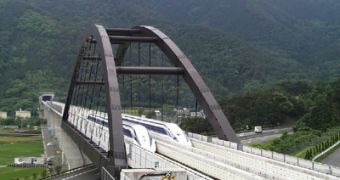A three-car version of the Superconducting Magnetically Levitated (MagLev) train achieved the world record of 581 km/h (361 mph) for a rail vehicle in December 2003, a record that still stands today. The vehicle relies on superconducting magnets and linear motor technology, which rule out the frictional forces generally caused by direct adherence of the wheels to the rail. According to its designers and testers from the Japanese National Railroads' Railway Technical Research Institute, this ensures extra high speeds, reliability, safety, minimum maintenance and a low environmental impact.
The three-decade old project was started in 1970 and currently plans are made in order to link the capital Tokyo with the Japanese cities of Osaka and Nagoya by a direct route through the Southern Japanese Alps, following the tests indicating that building such a railway is possible. This will provide an hour and a half ride for a distance of about 550 km, which is currently covered by bullet trains of the Nozomi type in about two hours and a half, and a 40 to 50 minute trip to Nagoya, located 263 km away, at a top speed of 500 km/h.
The basic functionality principle relies on a three-phase alternating current induced by a substation. Also, it's based on the fact that MagLev is a superconducting magnet to which the coils in the rails react in two ways: they generate a repulsion force in the proximity, where the train is, propelling it further, while the coils farther away from the car generate an attraction force, pulling the train towards them. The repulsion and attraction forces are also used to always keep the train at the center of the guide way.
The initiative has gained a lot of support in the country, which is easily understandable, considering that the Japanese are highly-active people who travel a lot. But while most seem content with the project, others question the integrity of the passengers, of those who inhabit the regions along the railway and of their properties, that of the surrounding environment and of the Southern Alps. Also, the profitability and the need for such a vehicle are taken into account, considering that the latest technologies allow for long distance communication and for less time spent traveling.

 14 DAY TRIAL //
14 DAY TRIAL //